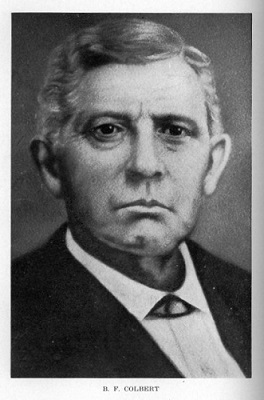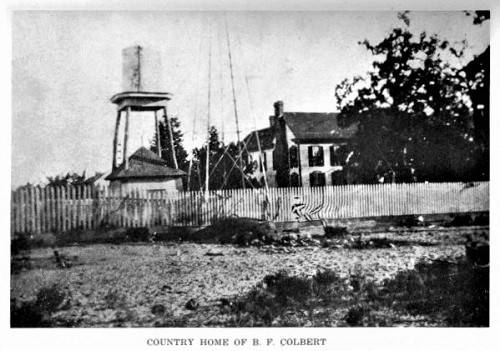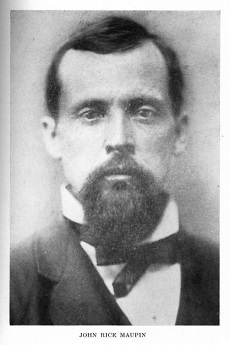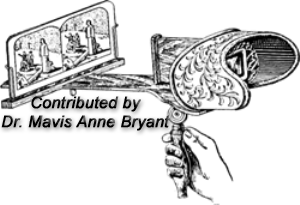  Benjamin
Franklin Colbert was born in Chickasaw country near Horn Lake,
Mississippi December 18, 1828. He died March 11, 1893. He
was the son of Martin and Sallie Allen Colbert, who were both
Chickasaw. His first wife was Martha McKinney, a Cherokee, by
whom he had two children - Mary, who married a white man by the name of
Thornton Downing. His second wife was Malinda Factor, a
Chickasaw, who died November 9, 1853. His third wife was George
Anne McCarthy, a white woman, by whom he had three children: Holmes (a
member of the Chickasaw Commission that negotiated the Atoka
Agreement); Texana, who married a white man (railroad agent at Colbert)
named Winter Bradley, for whom the the town of Bradley, Oklahoma was
named; and Eugenia, who was educated at Miss Mary Baldwin's Seminary at
Staunton, Virgina and married Lucien Perry.
His fourth wife was Lou Goldsby, a Cherokee, by whom he had nine children, only five of whom reached maturity, namely, James Colbert, now deceased, May, now of Columbia, Missouri, who married Wyatt S. Hawkins, of Hannibal, Missouri, Frances, now of Tulsa, Oklahoma, who married W. M. Baker, of Staunton, Virginia, Harley and Richard, both of whom reaching mature manhood, are now dead. The two daughters, May and Frances, were also educated at the Baldwin Seminary at Staunton, Virginia. Colbert became a successful cotton planter and owned twenty-five slaves before the Civil War broke out.    There was no stove, only skillet and lids for baking. I don't know how they did so much cooking for there were never less than from ten to twenty eating there. However, they put up good food and plenty of it. On the northwest, about thirty yards from the main house there was a cottage, twenty by twenty feet, with double beds and fireplace. They called it the office. The main house had a large veranda in front, also a Bermuda grass yard with three or four large oak trees, and there was a good orchard on the southwest side. On the east side was the garden, with some two or three graves. East of the garden was the barn and north of the barn the cow and hog lots with a large lot of near five acres in Bermuda grass. It was a pretty place. The main road was about one-fourth of a mile north of the house and led down to the ferry. Several hundred acres were in cultivation and there were houses for the Negroes in different parts of the fields. It was a stage-stand where the coaches changed horses and drivers. One coach went south at night and the other went north usually about noon. They always had two drivers, one for each way. Colbert kept around 100 head of hogs and milked eight to ten cows. He owned a ranch about twelve or fifteen miles northeast, where he kept several hundred head of cattle. After a few years he moved all his cattle up near Erin Springs where he broke out a large farm and fed his stock of beef cattle. His oldest son, Martin Colbert, had charge of this farm. "The Colbert home, a one-story double log house, became the Butterfield's station for changing horses and feeding and lodging passengers . . . Frank became one of the richest and most prominent members of the Chickasaw Nation; owning large herds of cattle, a steam-driven sawmill, a gristmill, a cotton gin, and hundred of acres of land on both sides of the river." Source : Bryant, Mavis Anne, Lives in Photography : Denison, Texas, 1872 - 1999, c2012; pgs. 91-93 There was a store on the Texas side about 200 yards from the ferry landing. In it were sold groceries, some dry goods and whiskey—it was called the "First and Last Chance." Coming from the north it was the first chance to get whiskey and was the last chance, if going north. It did a good business. There were only two houses between the river and Carriage Point, a distance of 12 miles. The first house was Dan Collins' on this (south) side of Colbert Station. At Carriage Point, Calvin Colbert, a half brother to B.F. Colbert, had a farm and ranch. There was no Durant then, or Calera, or Caddo. Up the river (west) there were only two or three farms; first was J. A. Smith's, then Jim Colbert's, then old Sam Love's. For ten miles down (east) the river road to Bloomfield there were two places, Charles Eastman's and Holmes Colbert's, the latter a cousin of Frank Colbert. Northeast about six or seven miles there were a few Indians by name of Hillhouse, and old Abijah Colbert, an uncle of B.F. Colbert, and some others around Bloomfield. There were a good many also towards Tishomingo and Rock Creek. If you found a trail through the woods, you would come to an Indian's cabin. They all lived away from any road. You could get on your horse and take a course with no fences to bother you. Grayson County, Texas, was very thinly settled then. Sherman, Texas, was our nearest town and it was just a very small place. There wasn't even a dwelling house and garden on the west side of the square.  Nearly every week or two, Indians would come four or more in a bunch, go across to the store and stay a few hours, come back loaded down with whiskey and feeling good. Then I had to keep my eyes open for they would shoot and we would have trouble. One day six of them came, stayed a few hours, then came back. Jim Hillhouse was Indian sheriff and he used to watch for them. That day he had been on the lookout, and when he met them at the turn of the hill not over 75 yards from the boat landing they went to shooting. Jim had the Indian constable with him. As travel was getting heavier one boat could not do the work, so about the first of March they put in another boat. Each boat could carry six to seven two-horse wagons. The upper boat ran on a steel cable moved down just far enough apart so that the two boats would not collide. I had now to look after both of them. Times were surely getting hot. The railroad bridge was building. Railroad outfits moving back and forth, and the further down the M. K. & T. got the more freight wagons crossed the river. Denison started to be a town, and it surely was a tough one. Towns north started as the railroad came along. The Texas Central was building at the time, and Warner was its (north) terminus. Several houses were built down in the bottom and a depot and town-site laid off with a man by name of Captain Faulkner selling town lots. There were two saloons, a dance hall, a hotel and a few dwellings, a turn table for cars, two or three big wells. Both tracks (M.K.&T. and H.&T.C.) ran side by side up to Denison. Finally they compromised but for a good while we thought the town would be in the bottom. Frank Colbert, John Maupin, Thornton Downing, and I bought 20 acres of land in an addition to Denison from Joe Lain, a farmer. Their one-half of it was on Main St. north—now worth millions. We got afraid that the town was going to be in the bottom and Colbert received a tip that it would be, so he and Maupin sold out to Munson. Colbert kept after me to sell night and day but I still held; he said that the town would be in the bottom, said he got it from the chief engineer, so I sold, like a fool, only doubling my money. Downing sold soon after that, but Denison kept growing.  The Sunday Gazetteer Sunday, May 17, 1908 pg. 4 HOME NEWS The old Frank Colbert homestead across Red River, north of the wagon bridge, was burned last Saturday night. The building was considered to be worth $5,000, but was insured for only $1,000. The property belonged to Mrs. Winter, of Durant. The origin of the fire is unknown.  The Sunday Gazetteer
Sunday, March 19, 1898 pg. 2 DEATH OF A NOTED INDIAN On Saturday evening of last week Mr. Frank Colbert was in Denison, having driven in with some members of his family. He complained of not feeling well and when his purchases and business had been attended to left for home, no one supposing that that would be Mr. Colbert's last trip to Denison. Such, however, was the case. Mr. Colbert retired earlier than usual, but still none of his family nor Mr. Colbert himself were seriously concerned. At midnight his condition became suddenly alarming, and at one o'clock he had ceased to breathe. Physicians had been summoned but Mr. Colbert was dead on their arrival. BIOGRAPHICAL Mr. Frank Colbert was born near Horn Lake in Mississippi something near 70 years ago. His father's name was Martin Holmes, and Frank was the eldest of 4 sons. He crossed the Mississippi river in 1836 and settled with his father on the north side of Red River near the present Colbert homestead. For a period of over half a century Mr. Colbert has devoted himself to stock-raising and farming. He has been 4 times married. His first wife was a Miss Martha McKinney, a Cherokee lady, by whom he had 2 children, Martin and Mary. His second wife was Miss Malinda Factor, to whom only one child was born, a girl. The third wife was Georgia Anne McCarthy. She was the mother of 3 children, a boy and 2 girls - Holmes, Texana and Jennie. The fourth and last wife was Miss Lou Goldsby, a Cherokee lady, and to whom 9 children have been born, 4 of whom are dead, 5 living, namely: Jim, May, Fannie, Harley and Richard. Mr. Frank Colbert was a fast friend of Denison. In 1873 and 1874 he constructed the Red River wagon bridge which, in the following June, was carried down by a freshet. In 1872 he sold to the Houston & Texas Central Railway company 5,000 acres of land lying along the south bank of the river, and on which was the site of Red River City, for $20,000, which was paid in gold. The remains were interred Tuesday evening in the old family burial ground. Seventy-five or one hundred people from Denison and a number from Sherman attended the funeral Tuesday afternoon. The services were conducted by Rev. Murrow, in the open air, as the house was not large enough to accommodate the friends who congregated to pay the last tribute to the memory of an old citizen and a good man. The remains were laid to rest in the family burial plot near the residence, and the ceremonies at the grave were conducted by the Masonic fraternity.  Biography Index Susan Hawkins © 2024 If you find any of Grayson County TXGenWeb links inoperable, please send me a message. |